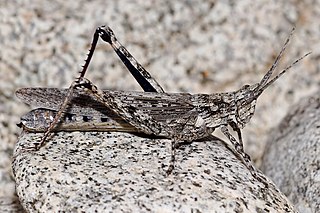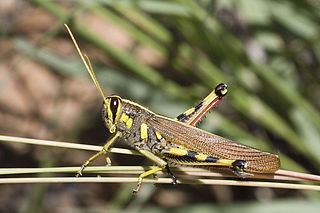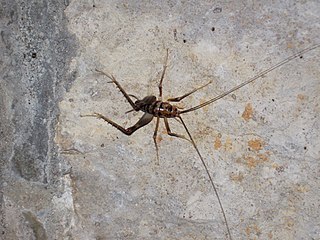
The Acrididae are the predominant family of grasshoppers, comprising some 10,000 of the 11,000 species of the entire suborder Caelifera. The Acrididae are best known because all locusts are of the Acrididae. The subfamily Oedipodinae is sometimes classified as a distinct family Oedipodidae in the superfamily Acridoidea. Acrididae grasshoppers are characterized by relatively short and stout antennae, and tympana on the side of the first abdominal segment.

The grasshopper subfamily Acridinae, sometimes called silent slant-faced grasshoppers, belong of the large family Acrididae in the Orthoptera: Caelifera.
Syrbula montezuma, known generally as the Montezuma's grasshopper or slant-faced grasshopper, is a species of slant-faced grasshopper in the family Acrididae. It is found in Central America and North America.
Conozoa nicola, the San Nicolas grasshopper, is a species of band-winged grasshopper in the family Acrididae. It is found in North America.

Schistocerca albolineata, the white-lined bird grasshopper, is a species of bird grasshopper in the family Acrididae. It is found in North America, often near the U.S.-Mexico border.

Achurum is a genus of slant-faced grasshoppers in the family Acrididae. There are at least three described species in Achurum.
Melanoplus discolor, the contrasting spur-throat grasshopper, is a species of spur-throated grasshopper in the family Acrididae. It is found in North America.
Trimerotropis melanoptera, the black-winged grasshopper, is a species of band-winged grasshopper in the family Acrididae. It is found in Central America and North America.
Ceuthophilus guttulosus, or Thomas' camel cricket, is a species of camel cricket in the family Rhaphidophoridae. It was described by Francis Walker in 1869 and is found in North America.
Melanoplus marginatus, the margined spur-throat grasshopper, is a species of spur-throated grasshopper in the family Acrididae. It is found in North America.
Paropomala virgata, the virgata toothpick grasshopper, is a species of slant-faced grasshopper in the family Acrididae. It is found in Central America and North America.

Ceuthophilus stygius, known generally as the Kentucky cave cricket or cave camel cricket, is a species of camel cricket in the family Rhaphidophoridae. It is found in North America.

Hadenoecus subterraneus, the common cave cricket, is a species of camel cricket in the family Rhaphidophoridae. It is found in North America.
Asemoplus is a genus of short-horned grasshoppers in the family Acrididae. There are at least three described species in Asemoplus.
Morsea is a genus of monkey grasshoppers in the family Eumastacidae. There are about seven described species in Morsea.

Psinidia fenestralis, known generally as longhorn band-wing grasshopper, is a species of band-winged grasshopper in the family Acrididae. Other common names include the long-horned grasshopper, long-horned locust, and sand locust. It is found in the Caribbean and North America.

Psinidia is a genus of band-winged grasshoppers in the family Acrididae. There are at least three described species in Psinidia.

Conozoa carinata, the ridged grasshopper, is a species of band-winged grasshopper in the family Acrididae. It is found in Central America and North America.
Heliastus is a genus of band-winged grasshoppers in the family Acrididae. There are about 10 described species in Heliastus.

Achurum carinatum, the long-headed toothpick grasshopper, is a species of slant-faced grasshopper in the family Acrididae. It is found in North America.







